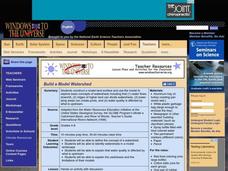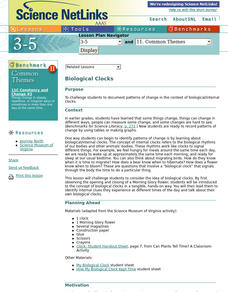Curated OER
Amounts of Dissolved Oxygen in Various Bodies of Water
Students test water to determine the dissolved oxygen content while displaying the proper use of testing instruments while visiting water testing sites. They determine if the amount of dissolved oxygen is appropriate for the tested...
Curated OER
Understanding the Water Cycle
Investigate the water cycle and how water moves from the land to the air and back to the land. Create a terrarium and observe the water cycle at work. Define weather terms including evaporation, condensation, and precipitation.
Curated OER
What Are The Properties of Sea Water?
Ninth graders conduct research on the subject of sea water. They use a variety of resources to obtain information. There are helpful resource links listed in the lesson. In conjunction with the research students make inquiry of the...
Curated OER
Testing the Waters
Eleventh graders examine a local body of water. In this science lesson, 11th graders collect water samples to test. Students analyze the data and make conclusions. Students create tables and graphs of the data.
Curated OER
Kids Conserve? Water Preserved
Sixth graders review the steps of the water cycle. Individually, they calculate the amount of water they use in a day and identify ways they can conserve. As a class, they discuss how conserving water today helps future generations and...
Curated OER
Water, Water Everywhere
Students study the location of Earth's water and study the water cycle using a terrarium. In this water study lesson, students study a model globe for the Earth and find Alaska. Students locate the bodies of water and study an overhead...
Curated OER
Build a Model Watershed
Collaborative earth science groups create a working model of a watershed. Once it has been developed, you come along and introduce a change in land use, impacting the quality of water throughout their watershed. Model making is an...
Curated OER
Is the Hudson River Too Salty to Drink?
Students explore reasons for varied salinity in bodies of water. In this geographical inquiry lesson plan, students use a variety of visual and written information including maps, data tables, and graphs, to form a hypothesis as to why...
Curated OER
Microscopic Water Life
Students use a light microscope to observe the organisms living in a sample of ocean or fresh water. Students create a drawing of the organisms that they observe. Students then discuss the different body plans of the organisms and the...
Curated OER
Water Quality Tests Explained
Students identify the eight tests done to check for water quality. In this ecology lesson plan, students explain why it's important to test water in rivers. They explore sources of river water pollution.
Curated OER
The Water Detectives
Students collect water samples from designated sampling stations, and discuss water pollution. They analyze the water samples, record the data on a spreadsheet, and present the environmental water quality data to the class.
Curated OER
The Water Cycle: A Repeating Pattern in Nature
Students are introduced to the terms related to the water cycle in their native language. In groups, they describe the steps of the cycle using different materials found in their art classroom. They describe how energy helps water...
Curated OER
Water 1: Water and Ice
Students investigate water in its solid and liquid form. In this states of matter lesson, students experiment to see what happens as water goes from a solid, ice, to a liquid, water, and back again. They write about and illustrate the...
Curated OER
Air and Water in the Environment
Second graders participate in a three part lesson in which they identify and describe forms of moisture in the environment. Part one of the lesson involves the three stages of the water cycle, part two focuses on creating humidity by...
Curated OER
Water Exploration Station
Students explore the characteristics of water. In this water exploration lesson, students participate in various learning centers to inquire how water drains and how to increase the flow of water. Students use estimation and measurement...
Curated OER
Comparing Microscopic Organisms in Fresh and Polluted Water: An Invitation To Inquiry
Students have the opportunity to develop and formulate ideas and explanations through the scientific standard of inquiry. They identify organisms by using an identification key for specific aquatic geographical area.
Curated OER
Making and Using a Gel Person to Teach Human Anatomy
Students investigate organs, anatomical planes and transverse sections of the human body using gel people. In this human anatomy lesson plan, students use gel molds, gel and food items to make models of the human body. They create a...
Curated OER
Using Our Five Senses
Students explore human anatomy by creating an oral report in class. In this five senses lesson, students read several real life situations and identify which of the five senses help in certain situations. Students create an oral...
Curated OER
Growth of a River
Students evaluate geography by drawing an image in class. In this river lesson, students identify a list of vocabulary terms associated with bodies of water. Students identify how a river is formed and draw a picture of one including the...
Curated OER
Zebra Mussels and Water Pollution
Research the proliferation of zebra mussels and their effects on local bodies of water. The class obtains zebra mussels and examines them, identifying their basic structures. They brainstorm ways the mussel may have been introduced to...
Curated OER
Water Tank Mural
Students evaluate visual arts by creating a mural on campus. In this symbolism instructional activity, students research famous artists on the Internet and examine the impact their work has had on society. Students create murals around...
Curated OER
Critter Clues
Learners work together to examine water quality. They identify the indicators of water quality and complete an experiment. They discuss their results.
Curated OER
Pollution Solutions: Earth Day
Eighth graders explore water pollution. In this stewardship lesson, 8th graders draw comparisons between potable and impaired waters. Students use the Learning Link website to examine ways people are fighting pollution and then design an...
Curated OER
Your Five Senses
Students identify the five senses. In this biology instructional activity, students participate in an experiment and use their five senses to identify various substances.























